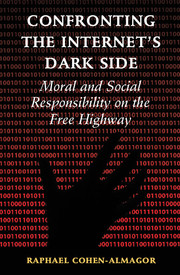Book contents
- Frontmatter
- Dedication
- Contents
- Acknowledgments
- List of Abbreviations
- Introduction
- 1 Historical Framework
- 2 Technological Framework
- 3 Theoretical Framework
- 4 Agent's Responsibility
- 5 Readers' Responsibility
- 6 Responsibility of Internet Service Providers and Web-Hosting Services, Part I: Rationale and Principles
- 7 Responsibility of Internet Service Providers and Web-Hosting Services, Part II: Applications
- 8 State Responsibility
- 9 International Responsibility
- Conclusion
- Glossary
- Selected Bibliography
- Index
2 - Technological Framework
Published online by Cambridge University Press: 05 July 2015
- Frontmatter
- Dedication
- Contents
- Acknowledgments
- List of Abbreviations
- Introduction
- 1 Historical Framework
- 2 Technological Framework
- 3 Theoretical Framework
- 4 Agent's Responsibility
- 5 Readers' Responsibility
- 6 Responsibility of Internet Service Providers and Web-Hosting Services, Part I: Rationale and Principles
- 7 Responsibility of Internet Service Providers and Web-Hosting Services, Part II: Applications
- 8 State Responsibility
- 9 International Responsibility
- Conclusion
- Glossary
- Selected Bibliography
- Index
Summary
We're changing the world with technology.
–Bill Gates
Never before in history has innovation offered promise of so much to so many in so short a time.
–Bill Gates
The aim of this chapter is to shed light on the technological aspects of the Internet. The chapter serves as a technological resource for the entire book. This resource bank is designed to make technological quandaries accessible to interested laypeople.
When visionaries such as J. C. R. Licklider, Robert W. Taylor, Vint Cerf, Larry Roberts, Robert E. Kahn, Ted Nelson, Leonard Kleinrock, and Douglas C. Engelbart first conceived of the Internet, they could not have imagined the fascinating state of the Internet today. Its rich and diversified nature and its wide circulation have benefited millions of users around the world. The Net serves as a communication medium comprising all other media. It is an infrastructure for digital commercial activities, an arena for a wide array of public debates and social networks, and a mega-size information resource.
The Internet presents a mode of technology that breaks the monopoly of conventional media. As Johannes Gutenberg's print machine broke the monopoly of the monks over books and brought about new ideas, so the Internet has changed how people think, communicate, and learn. This interactive medium is different from the print and electronic media. Its construction enables anybody and everybody, people who have access to conventional media as well as those who are denied access, to voice their opinions, even the vilest and most disturbing opinions.
First, the Internet is about communication. It comprises the basic components of communication: a sender, a message, a channel, and a receiver. Generally speaking, the Internet also provides opportunity for feedback. One Netuser can receive data from and send data to one or many other Netusers.
Second, the Internet is based on packet switching – technology that uses connectionless protocols for host-to-host resource sharing.
- Type
- Chapter
- Information
- Confronting the Internet's Dark SideMoral and Social Responsibility on the Free Highway, pp. 34 - 48Publisher: Cambridge University PressPrint publication year: 2015



